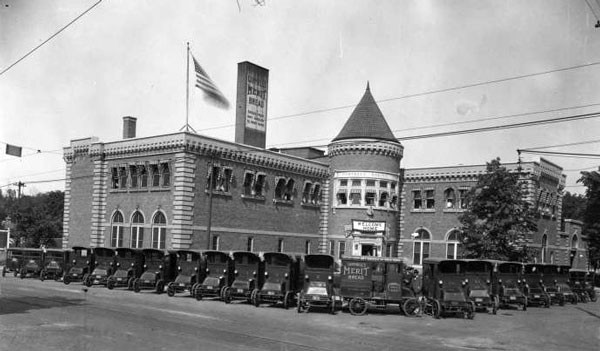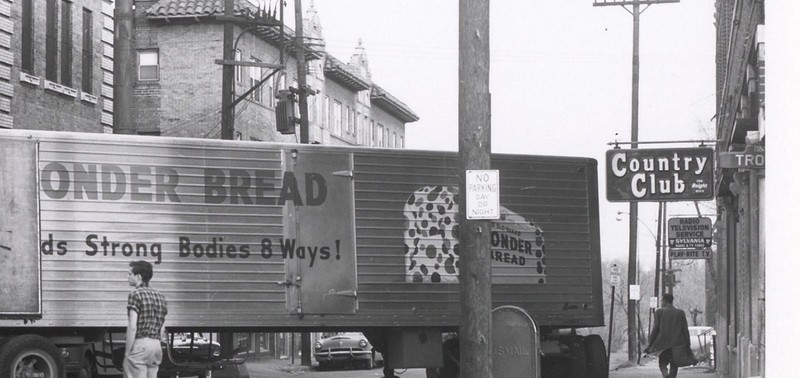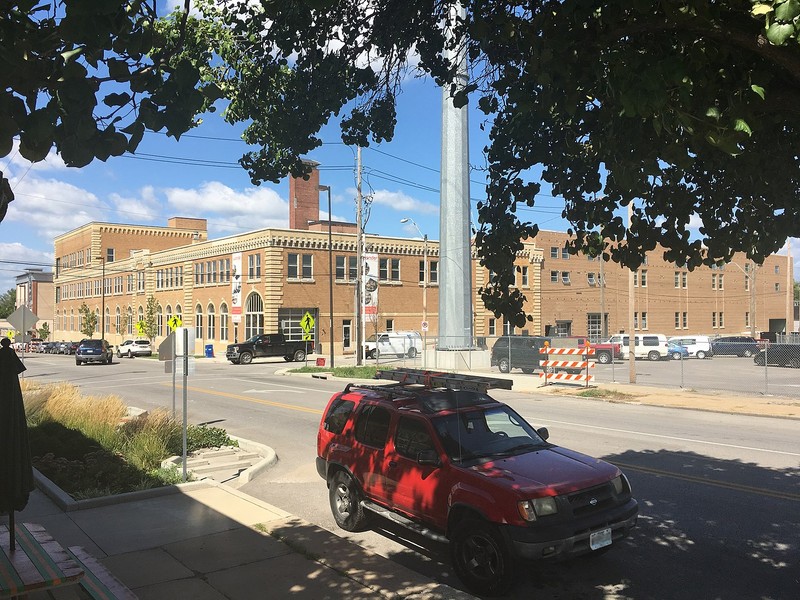Campbell-Continental Baking Company Building (Wonder Shops and Flats)
Introduction
Text-to-speech Audio
Now known as Wonder Shops & Flats, this building served the Campbell-Continental Baking Company and other companies that later purchased the business from 1915 to 1997. In those years, this distinctive structure was home to ovens and people who produced Wonder Bread among other breads and pastries. The original company was created in an era when Kansas City's flour and baking industries flourished owing to the abundance of farms in Kansas City's hinterlands coupled with the growing urban population. By the early 1900s, these factors inspired investors to create several large bakeries that could provide large quantities of commercially-produced bread to a population of households that were turning towards the market for items like bread that were previously produced in the home or at small neighborhood bakeries. The former bakery is located on Troost Avenue, a street that symbolized commercial growth in the early 20th century and racial divisions in the decades that followed as Troost became the de facto line by 1950. In recent years, organizations have made a concerted effort to rejuvenate the area by developing businesses and homes that cater to a variety of social and economic classes. The new Wonder Flats exists as part of that effort with a variety of businesses and apartments, although some have raised concerns about potential unintended consequences of investment if leads to some of the current residents facing an increased cost of living.
Images
Campbell-Continental Baking Company Building in 1918

Wonder Bread Trust at the Campbell-Continental Baking Company Building in 1945

Campbell-Continental Baking Company Building

Backstory and Context
Text-to-speech Audio
Constructed in 1915 and expanded from 1924-25, the Campbell-Continental Baking Company Building (also known as the Wonder Bread Building) was created during Kansas City's commercial baking industry boom in the early twentieth century. Increased urbanization along with changing economies and work cultures led to growing numbers of people buying bread instead of baking it at home. At the turn of the twentieth century, two-thirds of the population baked bread at home. By 1930, that ratio had shifted and two-thirds of households purchased commercially-made bread. By the mid-twentieth century, Troost Ave transitioned from a once-thriving business center to an ipso facto demarcation line between social and racial classes, leading to a decline in commercial activity on and near Troost. Today, the building is now known as the Wonder Shops & Flats, a mixed-use building with apartments and stores. It operates as part of a revitalization project known as the Troost Market Collective, which involves a concerted effort to celebrate artwork and bring businesses back to Troost, including minority-owned companies. However, the new apartments do not include affordable housing units, which has sparked concern among those attempting to help those in need within the neighborhood.
In the early 1900s, Kansas City stood as one of the nation's top flour milling centers, aided by the abundance of nearby wheat farms. By 1919, Kansas City boasted the nation's second-largest flour output. The immense flour production coupled with technological advances eventually inspired entrepreneurs to not only distribute flour but mass-produce baked goods (finished products), notably because urban dwellers often maintained jobs that included working long hours outside the home. Hence, little time existed for baking bread, crackers, or biscuits (but they had enough money to buy it).
Brothers Brayton and Win Campbell, Kansas City natives, founded the Campbell-Continental Building in the early 1910s. The company quickly thrived. In 1912 they operated a plant in Des Moines, Iowa, and by 1914 they opened a bakery in Wichita, Kansas. In 1915, the company expanded its operations and erected a new production facility (the historic building that survives today) in Kansas City. They chose a strategic location at the corner of 30th Street and Troost Avenue, which allowed for easy distribution to customers in the surrounding commercial and residential areas along and near Troost Ave. During the early twentieth century, baking companies that focused primarily on non-perishable items, such as crackers, usually operated in facilities close to rail lines. However, bread-focused companies like Campbell-Continental (in the days before additives and preservatives) had to provide timely delivery to retailers and consumers. Thus, they generally occupied facilities close to residential neighborhoods.
The historic bakery arose when the neighborhood was in the midst of a transition from mansions to working- and middle-class homes, hotel apartments, and commercial buildings. The Campbell-Continental Baking Company Building stood as one of the largest and most ornate bread-baking facilities in Kansas City. The historic building's Italian Renaissance Revival with its ornate architectural detailing represented the company's prominence and the scale of its production output. Furthermore, the design projected a sense of hygiene and cleanliness. Progressive-Era attitudes and philosophies affected commercial bakers in the same fashion as most other industries. Around 1901, the National Association of Master Bakers (later known as the American Bakers Association) actively pursued reforms in sanitation and working conditions. In turn, companies proudly marketed their new, clean facilities to enhance customer confidence; a factory's exterior design had to exude a sense of cleanliness, including everything from its modern design to developing automobile bays, which replaced horses and their messy stables. In fact, Campbell Baking Company parked its fleet of thirty delivery vehicles (40 by 1920) along Troost Avenue, which served as a promotional tool.
Campbell expanded significantly mid-twentieth century, including during the Great Depression. In 1922, Campbell merged with two successful baking companies to form United Bakeries Corporation -- the company operated nine plants in seven states by 1922. Another merger in 1924 resulted in the formation of the Continental Baking Corporation. Each merger helped the company grow and subsequently expand its now-historic baking facility. Moreover, during the late 1920s, the company began an aggressive advertising campaign focused on Continental's signature Hostess and Wonder Bread brands. By 1933, despite the onset of the Great Depression, Continental operated more than 100 plants, including the historic building on Troost Ave, and stood as the nation's largest commercial baking holding corporation. In 1957, the company had $307.9 million in sales and operated bakeries and distribution centers in thirty-nine states and Washington D. C.
Troost Avenue changed profoundly after World War II, notably by the 1960s and 1970s. Troost Avenue ostensibly evolved into a dividing line between social classes, most of it directly tied to racial divisions. Numerous high-end homes and hotels built west of Troost included covenants that prohibited Black or Jewish residents from owning them. For decades, the average income of people living west of Troost far exceeded those living east. As a result, Troost Avenue's significance declined dramatically. Still, even after Ralston Purina acquired Continental Baking Company in 1984 and Interstate Bakeries acquired the baking company in 1995, the historic Campbell-Continental Building continued to produce Wonder Bread and Hostess products; the end finally arrived in 1997.
In 2018, the Wonder Shops & Flats took ownership of the Wonder Bread building and converted it into a mixed-use building of nearly ninety apartments, retail spaces, and food options. A faded Wonder Bread logo adorns the lobby wall, Twinkie baking sheets line the walls, and old, previously used bread mixers ostensibly serve as artwork. Although organizations are seeking to create a new type of Troost Avenue that's inviting to a variety of social and racial classes, the new apartment complex caterers to the same social class that once frequented Troost Ave in the early twentieth century (those with financial means). The Wonder Flats offer guests a wide range of services and amenities. Fox4 (Kansas City) reported, that Diane Cleaver of the Urban Neighborhood Initiative was encouraged by the investment and development along Troost, but hoped that there would still be affordable housing and also hoped that new investment would serve the existing families of the community.
Sources
Collison, Kevin. "Developers Propose Ambitious Plan To Revive Kansas City's Historic Troost Business District." NPR: KCUR. kcur.org. May 20, 2019. https://www.kcur.org/arts-life/2019-05-20/developers-propose-ambitious-plan-to-revive-kansas-citys-historic-troost-business-district.
Honeycutt, Sherae, "KC's old Wonder Bread building gets new slice at life with renovation on Troost." Fox 4 Kansas City. fox4kc.com. April 4, 2019. https://fox4kc.com/news/kcs-old-wonder-bread-building-gets-new-slice-at-life-with-renovation-on-troost/.
Nugent, Rachel and Lauren Rieke. "Nomination Form: Campbell-Continental Baking Company Building." National Register of Historic Places. mostateparks.com. 2016. https://mostateparks.com/sites/mostateparks/files/Campbell-Continental%20Banking%20Co.%20Bldg.pdf.
Salzman, Eric. "For decades a dividing line, Troost Avenue in Kansas City, Mo., sees new hope." NBC News. October 12. 2018. https://www.nbcnews.com/news/us-news/decades-dividing-line-troost-avenue-kansas-city-mo-sees-new-n918851.
Troost Market Collective. https://www.troostmarketcollective.org/.
From MidTown KC Post (http://midtownkcpost.com/campbell-baking-company-dominated-the-block-at-30th-and-troost/)
Anderson Photo Company via KCHistory.org at https://kchistory.org/islandora/object/kchistory%3A129912?
By Bartokie - Own work, CC BY-SA 4.0, https://commons.wikimedia.org/w/index.php?curid=71716974
